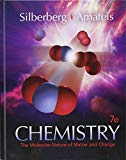
Concept explainers
(a)
Interpretation:
The fraction of volume in a helium atom occupied by the nucleus is to be determined.
Concept introduction:
Atom is a neutral particle. The presence of an equal number of protons and neutrons make atom a neutral species. Protons are positively charged particles that along with the neutral particles neutrons, make up the nucleus of an atom. The nucleus of an atom is densely packed and occupies a very small volume in the atom at the center. Electrons are negatively charged particles that revolve around the atomic nucleus due to the electrostatic force of attraction between the protons and the electrons.
The formula to calculate the volume of the spherical helium atom is,
The formula to calculate the volume of the spherical nucleus is,
The formula to calculate the fraction of the volume of atom occupied by the nucleus is,
(b)
Interpretation:
The fraction of the
Concept introduction:
Atom is a neutral particle. The presence of an equal number of protons and neutrons make atom a neutral species. Protons are positively charged particles that along with the neutral particles neutrons, make up the nucleus of an atom. The nucleus of an atom is densely packed and occupies a very small volume in the atom at the center. Electrons are negatively charged particles that revolve around the atomic nucleus due to the electrostatic force of attraction between the protons and the electrons.
The general formula to calculate the total mass of the electrons in a
The general formula to calculate the mass of the nucleus of an atom is,
The general formula to calculate the mass fraction of the nucleus of an atom is,
Want to see the full answer?
Check out a sample textbook solution
Chapter 2 Solutions
GEN CMB CHEM; CNCT+;ALEKS 360
 ChemistryChemistryISBN:9781305957404Author:Steven S. Zumdahl, Susan A. Zumdahl, Donald J. DeCostePublisher:Cengage Learning
ChemistryChemistryISBN:9781305957404Author:Steven S. Zumdahl, Susan A. Zumdahl, Donald J. DeCostePublisher:Cengage Learning ChemistryChemistryISBN:9781259911156Author:Raymond Chang Dr., Jason Overby ProfessorPublisher:McGraw-Hill Education
ChemistryChemistryISBN:9781259911156Author:Raymond Chang Dr., Jason Overby ProfessorPublisher:McGraw-Hill Education Principles of Instrumental AnalysisChemistryISBN:9781305577213Author:Douglas A. Skoog, F. James Holler, Stanley R. CrouchPublisher:Cengage Learning
Principles of Instrumental AnalysisChemistryISBN:9781305577213Author:Douglas A. Skoog, F. James Holler, Stanley R. CrouchPublisher:Cengage Learning Organic ChemistryChemistryISBN:9780078021558Author:Janice Gorzynski Smith Dr.Publisher:McGraw-Hill Education
Organic ChemistryChemistryISBN:9780078021558Author:Janice Gorzynski Smith Dr.Publisher:McGraw-Hill Education Chemistry: Principles and ReactionsChemistryISBN:9781305079373Author:William L. Masterton, Cecile N. HurleyPublisher:Cengage Learning
Chemistry: Principles and ReactionsChemistryISBN:9781305079373Author:William L. Masterton, Cecile N. HurleyPublisher:Cengage Learning Elementary Principles of Chemical Processes, Bind...ChemistryISBN:9781118431221Author:Richard M. Felder, Ronald W. Rousseau, Lisa G. BullardPublisher:WILEY
Elementary Principles of Chemical Processes, Bind...ChemistryISBN:9781118431221Author:Richard M. Felder, Ronald W. Rousseau, Lisa G. BullardPublisher:WILEY





